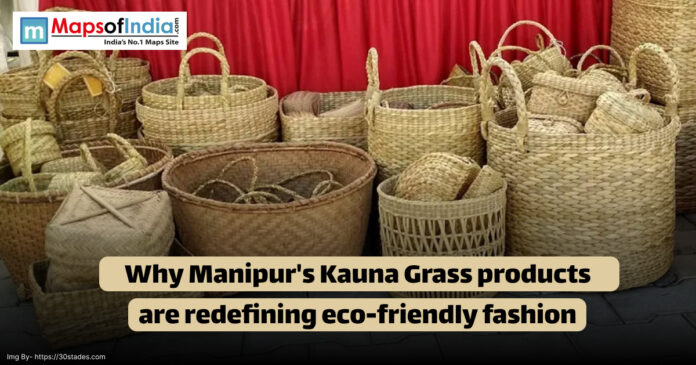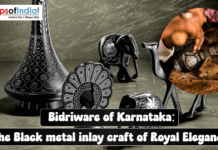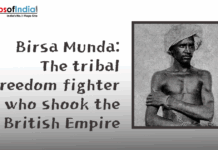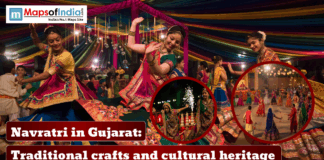Manipur’s kauna grass products are changing the landscape of what we know as eco-friendly fashion. Kauna are humble water reeds that are grown in Imphal’s wetlands. They are afterwards woven into stunning bags, baskets, and mats, which give an authentic feel. The items created using these blend traditional art with modern style. The products made from these are sustainable, durable, and rooted in the culture of northeast India. Artisans craft them with skills passed down through generations. Most craftsmen are women. Kauna products have gained global attention. The product created by using Kuana offers an alternative to plastic and fast fashion.
The Roots of Kauna Grass Craft
Kauna is a kind of grass that grows in water. This grass belongs to the Cyperaceae family. It mostly grows in Manipur’s marshy Imphal valley. Farmers cultivate this grass alongside rice. This grass grows up to 10 feet tall. Kauna grass is in a cylindrical shape. The grass has spongy stems, which make it ideal for weaving. Kauna grass is harvested three times a year. To get it properly, it’s cut near the base. Artisans dry it under the sun to remove moisture in grass. Some artists preserve it by smoking. The product made from kauna was used for utility items. Things like Mats, cushions, and baskets served Manipuri households. These items supported the Meitei tradition of floor-based socializing. Today, kauna’s versatility fuels its rise in fashion. Its natural and biodegradable properties make it a sustainable and environmentally friendly choice.
Artisanal Craftsmanship Meets Modern Design
Products made using Kauna grass show intricate weaving it. Artisans create tight and durable patterns in products. Each weave has a unique name, like cowrie shell or diagonal. Baskets made from kauna have a firm base and open upper weaves. This keeps the contents in the basket fresh. Bags have foldable handles or cane straps. Some bags include embroidery or leather accents. Through these products, we can see the modern touch in traditional art, which appeals to urban buyers. In recent days, some artisans like Nitya Moirangthem have experimented with shapes. making things like Tote bags, clutches, and planters, which reflect contemporary tastes. Organizations like Ziveli train weavers for urban markets. According to a recent study, it has been noted that artisans are tripling their incomes through new designs. The craft blends heritage with innovation. The products made from these are both functional and fashionable.
Empowering Women and Communities
Kauna weaving is mostly done by women in the Manipur region. In villages like Khangabok, women drive this craft. Artists like M. Romita Devi earn ₹12000 monthly weaving kauna mats and bags. With this money, she supports her five children. Most weaver who are women earns ₹8000 to ₹15000 monthly. Women in this region balance family and craft. Women like Takhelei Sundrei, called Ima Yai, empower others. The local woman trains other woman artisans and connects with markets. According to a recent Village Square report, it has been seen that 2000 women in Khangabok are working as kauna weavers. There are many NGOs like ODESH that support more than 150 women to pursue their art. These organisations ensure that women get fair wages and market access. The globalisation of kauna products has strengthened Manipur’s rural economy. Kauna fashion is a tool for empowerment.
A Sustainable Alternative to Plastic
The products made by using Kauna grass are eco-friendly. These products are 100% biodegradable and decompose naturally. Which is the exact opposite of plastic. The grass is renewable and harvested without causing any harm to the environment. The root of the kauna grass stabilises wetlands and supports the natural fish habitats. Mats and baskets made from kauna last for years. These products resist moisture, decay, and pests. Laundry baskets keep clothes fresh with open weaves. Kauna bags are now replacing single-use plastic bags in the market. Consumers choose them over plastic. Global brands are promoting kauna as a green choice. The use of the Kauna product reduces plastic from the market.
Cultural Significance and Global Appeal
These products made from Kauna carry deep cultural meaning. In Manipur, mats called phaks are essential. These mats are used in weddings for seating the bride and groom. These mats’ edges have auspicious odd-numbered knots, which are often 15. Baskets served traditional needs, like carrying vegetables and daily groceries. Nowadays these bags are fashion statements. According to e-commerce platforms, Kauna bags highlight their aesthetic appeal more. Buyers in cities love the rustic charm of these bags. In International markets demand for these eco-friendly crafts is increasing rapidly. Products made by Kauna have minimalist designs that suit modern tastes. They bridge Manipur’s heritage with global fashion.
Economic Impact and Market Growth
The surge in Kauna crafts in the international market has boosted Manipur’s economy. Before, Artisans used to earn little they did not know the cost of their work. Tourists bought these products at a low price. But now, organisations like Dastkari Haat Samiti and many NGOs ensure that artists get a fair price for their products. ODESH connects weavers to retailers. Artisans earn ₹10000 to ₹15000 monthly after getting proper training. The craft supports farmers too. Kauna cultivation is done with the rice crop. Also, the Fish in the kauna field water add to the farmer’s revenue. One Kauna bags sell for ₹1399 to ₹2099 on e-commerce platforms. This creates a sustainable ecosystem. From farmers to weavers, everyone benefited from kauna.
Challenges and Future Opportunities
Even though the Kauna products are successful, they face many challenges. Some artists follow traditional designs that lack urban appeal. Artisans needed training for the needs of modern markets. Ziveli addressed this issue by introducing trendy designs and training weavers for this. Inconsistent quality can deter buyers. Scaling production is another challenge. Demand outpaces supply in 2025. More training centres are needed. The crafts need to expand. Climate changes threaten wetlands, which are affecting the growth of kauna. The future of this art is bright with some innovation. Planters and clutches show product diversification. With support from the government, Kauna products can dominate the eco-fashion market. Continued investment ensures its longevity.
Conclusion
Kauna grass products are made in a small region in Manipur and are now defining eco-friendly fashion on the global stage. These kauna grass products have a blend of traditional art with modern style. This art form is led mostly by women, which is empowering local communities. The biodegradable nature of kuna grass can make it an alternative to plastic. These products have many Cultural significance, adding depth while global appeal drives demand. Economic benefits are uplifting local farmers and weavers. Challenges like quality and scale are there. In recent years, kauna bags, baskets, and mats have become more than fashion. They’re the symbol of the movement for sustainability and heritage. It’s a small choice with a big impact.





